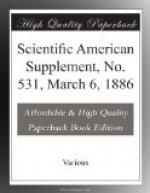-----------------------------+---------+---------+-----
----+--------- | I. | II. | III. | IV. +---------+---------+---------+--------- |per cent.|per cent.|per cent.|per cent. Ferric oxide (Fe_{2}O_{3}). | 26.08 | 61.60 | 82.71 | 80.55 Ferrous oxide (FeO). | 60.40 | 23.90 | 5.18 | 1.08 +---------+---------+---------+--------- Total. | 86.48 | 85.50 | 87.89 | 81.63 +---------+---------+---------+--------- Calculated: | | | | Ferric oxide (Fe_{2}O_{3}). | ... | 8.49 | 59.77 | 77.75 Magnetic oxide (Fe_{3}O_{4}).| 37.82 | 77.01 | 28.12 | 3.88 Ferrous oxide (FeO). | 48.66 | | | +---------+---------+---------+--------- Total. | 86.48 | 85.41 | 87.89 | 81.63 +---------+---------+---------+--------- Percentage of total oxygen reduced. | 24.03 | 10.02 | 2.26 | 0.49 Metallic iron. | 65.24 | 61.71 | 61.93 | 57.23 -----------------------------+---------+---------+---------+
---------
NOTE.—All the carbon dioxide (CO_{2}) occurring in the ore as calcic carbonate was expelled.
Third Experiment, Carbon monoxide (CO).—The tube A was filled with anthracite in the manner described for the second experiment, and heated to drive off the volatile matter, before the ore was placed in the upper tube, B, and the anthracite was divided from the ore by means of a piece of fine wire gauze. The lower tube, A, was heated to the temperature of white heat, the upper one, B, to a temperature of bright red. I. Layer, 1 in. thick from the bottom; ore dark brownish colored. II. Layer 4 in. thick above I.; ore reddish brown. III. Layer 11 in. thick above II.; ore red color. The analyses gave:
-----------------------------+---------+---------+-----
---- | I. | II. | III. +---------+---------+--------- |per cent.|per cent.|per cent. Ferric oxide (Fe_{2}O_{3}). | 43.26 | 78.91 | 77.74 Ferrous oxide (FeO). | 37.86 | 3.46 | 1.44 +---------+---------+--------- Total. | 81.12 | 82.37 | 79.18 +---------+---------+--------- Calculated: | | | Ferric oxide (Fe_{2}O_{3}). | ... | 71.23 | 74.54 Magnetic oxide (Fe_{3}O_{4}).| 62.72 | 11.14 | 4.64 Ferrous oxide (FeO). | 18.40 | | +---------+---------+--------- Total. | 81.12 | 82.37 | 79.18 +---------+---------+--------- Percentage of total oxygen reduced. | 16.44 | 1.49 | 0.42 Metallic iron. | 59.73 | 57.93 | 55.54 -----------------------------+---------+---------+---------<
/pre>NOTE.—The carbon monoxide (CO) had failed to remove from the ore the carbon dioxide existing as calcic carbonate. The summary of experiments in the following table appears to show that the water gas is a more powerful reducing agent than CO in proportion to the ratio of as




